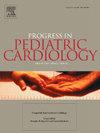卵圆孔装置闭合术后的长期疗效:单中心经验
IF 0.6
Q4 PEDIATRICS
引用次数: 0
摘要
本文章由计算机程序翻译,如有差异,请以英文原文为准。

Long-term outcomes following patent foramen ovale device closure: A single-center experience
Background
Patent foramen ovale (PFO) transcatheter closure is recommended for carefully selected patients with cryptogenic stroke and transient ischemic attack (TIA). It has also been associated with significant improvement in the severity of refractory migraine headaches.
Objective
To report long-term outcome after PFO closure for patients with stroke, TIA, and refractory migraine.
Methods
This retrospective study represents a single-center experience including patients undergoing PFO transcatheter closure for stroke, TIA, or refractory migraine. Patients were followed at 1 and 6 months, one year, and then annually for at least 5 years after closure. After that, patients either attended annually or were followed by telephone interviews. Holter monitoring was done 1–3 months after closure, then selectively according to patient symptoms.
Results
We enrolled 480 patients undergoing PFO transcatheter closure between March 2001 and July 2020. 432 patients completed follow-up through August 2024. The follow-up duration ranged from (4–23) years. PFO closure was successful in all patients without complications. New onset atrial fibrillation (AF) occurred in 6 patients (1.39 %), typically later during follow-up (14.0 ± 4.1 years), all with cardiovascular risk factors. Cerebrovascular events recurred 0.31 events/100 person/years. Using the Log-rank test, event recurrence was more observed in patients >40 years in the presence of other cardiovascular risk factors and AF. Regarding Migraine, (82.4 %) of patients experienced complete resolution of symptoms, and (17.6 %) reported mild symptoms (Migraine Disability Assessment Questionnaire (MIDAS) grade I). The mean MIDAS score significantly improved; the mean before closure was 28.3 ± 7.23 and 0.83 ± 1.82 after closure (P = 0.001). The migraine persistence rate was 1.9 events per 100 person-years.
Conclusions
Percutaneous PFO closure is a safe and effective long-term intervention for preventing recurrent cerebrovascular events and significantly improves migraine symptoms.
求助全文
通过发布文献求助,成功后即可免费获取论文全文。
去求助
来源期刊

PROGRESS IN PEDIATRIC CARDIOLOGY
PEDIATRICS-
CiteScore
0.90
自引率
11.10%
发文量
69
审稿时长
75 days
期刊介绍:
Progress in Pediatric Cardiology is an international journal of review presenting information and experienced opinion of importance in the understanding and management of cardiovascular diseases in children. Each issue is prepared by one or more Guest Editors and reviews a single subject, allowing for comprehensive presentations of complex, multifaceted or rapidly changing topics of clinical and investigative interest.
 求助内容:
求助内容: 应助结果提醒方式:
应助结果提醒方式:


